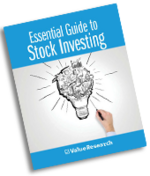
Value Research Stock Advisor has just released a new stock recommendation. You can click here to learn more about this premium service, and get immediate access to the live recommendations, plus new ones as soon as they are issued.
Mutual fund investors inevitably come across the abbreviated term 'NAV'. No matter how hard they try to keep investment jargon at bay, this is one term that keeps cropping up (for instance, when buying and selling mutual fund units). It is not surprising then that there are many misconceptions about what it means. As a mutual fund investor, knowing what NAV is and what it entails is certainly helpful.
The NAV formula
NAV or net asset value is the sum total of the market value of all the shares held in a portfolio, including cash, less liabilities, divided by the total number of units outstanding. Thus, the NAV of a mutual fund unit is nothing but the 'book value' of a unit.
Is a low NAV good?
One often comes across investors who feel that a fund with a low NAV is 'cheaper' than one with a higher NAV. Furthermore, at the time of a new fund offer, many distributors push the new fund by pointing to its low NAV, seeming to indicate that it is available at a bargain.
The truth is that NAV itself is of no consequence. The idea that a low-NAV fund is cheap is a result of investors comparing NAV with stock price. A low stock price (when seen in terms of valuation) means a stock is available at a bargain. But this is not true for a fund's NAV. NAV doesn't tell you whether a fund is cheap or expensive. It just reflects the current value of one unit of the portfolio.
An example
The following example will make it clear that returns are independent of NAV. Say, you have Rs 10,000 to invest. You have two options, Fund X and Fund Y, whose portfolios are the same but whose NAVs are different. Fund X has an NAV of Rs 10 and Fund Y has an NAV of Rs 50. So with your money you get either 1,000 units of Fund X or 200 units of Fund Y. After one year, both funds will have grown equally as their portfolios are the same.
Let's assume that the funds have grown by 25 per cent. Then the NAVs after one year will be Rs 12.50 for Fund X and Rs 62.50 for Fund Y. The value of your investment will be 1,000*12.50 = Rs 12,500 for Fund X, and 200*62.5 = Rs 12,500 for Fund Y. Thus, your returns will be the same, irrespective of the NAV.
When we buy a mutual fund at its NAV, we are buying it at its book value. And since we are buying it at its book value, we are paying the right price for its assets, whether it is Rs 10 or Rs 100. What you want to buy in a scheme is its performance, not its NAV. And the simplest way to do this is to compare returns over similar periods.









